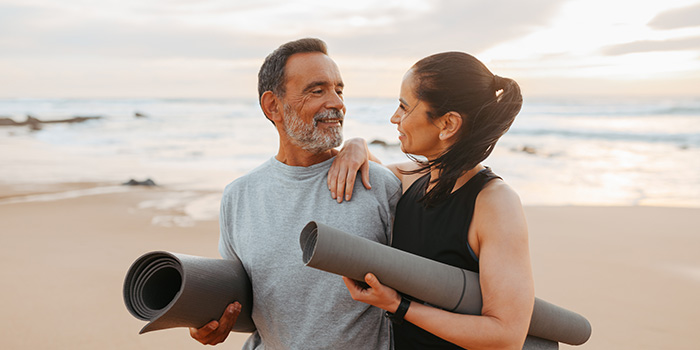Building Balance – Part One

Building Balance – Part One
Talk about retro comebacks…
Remember these iconic fitness trends from the 70’s and 80’s? They’ve returned with a few modern twists:
- Jane Fonda’s leg warmers are keeping calf’s toasty in gyms across the country.
- New Jazzercize studios are popping up with playlist that replaces the Bee Gees with Beyonce.
- Even the Thigh Master is squeezing its way back with a 2023 model that boasts a “built in smart chip.”
There’s one thing that never goes out of style in the quest to stay fit, strong and independent and to avoid the number one cause of death among seniors –– falls.
Read on to learn about the connection between building balance and avoiding falls.
Move A Little, Gain A Lot
Recent findings from the Centers for Disease Control and Prevention and the National Exercise Guidelines show that regular physical activity contributes to:
- Better brain health
- Weight management
- Stronger bones and muscles
- Less pain from arthritis
- Lower risk of diseases like heart failure and cancer
And a lower risk of falling.
36 Million Reasons Why You Should Improve Your Balance
It’s never been more important to focus on balance. New data from the CDC finds that:
- Of the 36 million falls a year, 32,000 people die.
- One out of five falls causes head injury, broken bones and other serious injuries.
- Every year, 300,000 seniors are hospitalized for hip fractures.
- Falls are the second leading cause of traumatic brain injury.
- Falls translate into $50 million a year in medical costs, with three-quarters of that paid by Medicare and Medicaid.
AgeRight’s Approach –– Building Balance, Building Confidence
AgeRight’s physical and occupational therapists specialize in creating tailored exercise programs that increase strength, endurance, balance and a big shot of confidence.
“Many patients are told that at their age, they can’t do certain activities. I like to validate my patients that they are much stronger than people have led them to believe. Our goal is to make patient’s feel safe within their homes and return to activities that they once enjoyed.”
“I see 20-30 patients a week in their homes and most of them are recovering from an acute medical episode or for recurrent falls. First, we determine overall risk factors; medication interactions, psychosocial status, specific medical conditions like low blood sugar levels that are contributing to falls and then we build an individualized program to improve quality of life. Our goal is the pursuit of happiness and building better balance is a key component in that!”
So, let’s get started with the first of 4 tips to improve your balance, recommended by the CDC, the Physical Activity Guidelines for America and from our own Sarah Shearer-Smith, PT, DPT, GCS, CEEAA, RAC-CTA. Sarah is Consonus Healthcare’s long-time Northwest Director of Clinical Services and one of a small number of clinicians in the US who is recognized as a trained geriatric specialist in physical therapy.
(An important disclaimer: Consult with your doctor before beginning or changing any activity program. Physical/occupational therapists can also be invaluable supports and experts: helping to identify which condition- or disease-specific guideline might be safest for you, what are the safest and most comfortable positions and modifications for exercises, if there are best times for exercise due to certain medications, and what are the recommended types/intensities/frequencies/and durations for each exercise.)
Tip #1 Warm Up/Cool Down
Want to avoid injuries? Warm-ups and cool-downs, with lower-intensity activities, are essential for the best circulation, breathing, and/or muscle demand to build up gradually. They also allow you to safely slow down after your workout.
The CDC and National Exercise guidelines for lower intensity and speed exercises include walking in water before water aerobics, walking slower before walking faster, walking before jogging, using lower weights or multi-joint movement exercises like standing on one foot and doing bicep curls. Ballroom dancing is another multi-joint movement exercise –– combining balance and aerobics.
Tip #2 Strengthen Your Sensory Abilities
Think of all the daily situations you’re in where the risk of falling is heightened: getting in and out of a vehicle or chair, navigating a narrow path, stepping over a threshold, walking to the bathroom in the dark, going up and down stairs and moving side to side. These exercises will help you mitigate those risky situations.
Your Footing: How long can you balance on one foot? If you’re in your 50’s, you should be able to stand on one leg for around 40 seconds; 20 seconds if you’re in your 60’s; and 10 seconds if you’re 70 and older. Why is that important?
A recent study suggests the inability to balance for 10 seconds on one leg is linked to an increased risk of death within ten years. Here’s how to get to your 10 seconds –– and beyond! Complete these exercises standing at a counter or table with eyes open. Place a chair behind you for added security.
- Feet Together and Tandem Stance: Place your feet together. Hold for 30 seconds. Move one foot in front of the other, heel-to-toe. Hold for 30 seconds. Exchange feet and repeat for 30 more seconds.
- Weight-Shifting: Next, return your feet to shoulder distance apart. Keeping your feet solidly on the ground, slowly move your weight to your heels, then toes, like shifting your weight from 6 o’clock to 12 o’clock (don’t rock). Repeat 10 times. Switch to slowly shifting your weight from right to left, or 3 o’clock to 9 o’clock. Repeat another 10 times.
- Reaching: Now, keep your feet solidly on the ground, shoulder-width apart, try to lift one hand off the counter or table and reach forward 5 times, then out to the side 5 times. Switch arms and repeat; forward 5 times, out to the side 5 times.
- One-Leg Stance: Finish up by trying to stand on one leg. Keep your hands on the counter or table and that chair behind you!) The goal is greater than 8-10 seconds. This is an important exercise because when you walk, you’re actually standing, briefly, on one leg.
In our next blog we’ll get your heart racing with our last two tips to improve your balance –– aerobic activity and strength shaping.
So, get started on your road to building balance and avoiding falls –– with or without the legwarmers!
Recent Posts
Aging Well At Home — Even With COPD
24th Nov 2023Building Balance – Part Two
18th Oct 2023Building Balance – Part One
21th Sep 2023© 2025 AgeRight Care at Home | Privacy Policy



